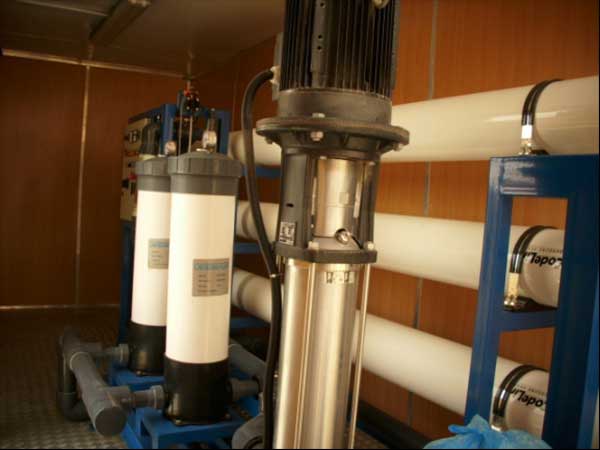Reverse osmosis system RO:
The most advanced water filtration, reverse osmosis (Reverse Osmosis) is in the process pressure from a series of semi-permeable membrane (Semi Permeable Membrane) is passed. The external pressure is higher than normal osmotic pressure as a result of smaller molecules from the pores of the membrane, passes while larger molecules are not able to pass through the membrane (Figure on a membrane pore diameter is observed that even the diameter of a virus is smaller than bacteria) and then in the side stream is passed through the membrane and excreted.
called diffusion membrane (permeate) water and salts left behind as the thick membrane (concentration) Myshnasnd.dr reverse osmosis process is not required and only the electrical energy into heat energy used to pump the physical processes that can reverse Mygrdd.asmz be made of almost pure solvent solution through a membrane. Reverse osmosis can be 99 percent higher material and colloidal minerals dissolved in water to remove the 97 per cent. Desalination Plants have many applications in various industries and each day will be added to the area.
The use of membrane technology (reverse osmosis) water treatment
Today, reverse osmosis and electrodialysis, both of membranes used in water treatment technologies play an important role. mass. in the world, it is predicted that if the problem is resolved membranes at high temperatures produce fresh water from sea water by reverse osmosis economy.
In addition, the following information useful and concise about this system is that your loved ones more familiar with how this technology reverse Mynmaydasmz
Reverse osmosis is a physical process that can be a solution (solvent + impurities) through a semi-permeable membrane, made almost pure solvent. For example, this method can of salted water, good drinking water provided. Reverse osmosis technology in recent decades with the arrival of new types of membranes, significantly expanded.
By RO
Reverse osmosis is a separation method of separating impurities from water is applied mechanical stress. Sometimes reverse osmosis filtration because the two processes are similar to separate impurities from the water. So sometimes reverse osmosis, Hayprfyltrasyvn say.
Reverse osmosis technology
In reverse osmosis raw water (untreated) into the pump chamber which is semi-permeable membrane, driven as nearly pure water can pass through the membrane into the water almost pure on one side of the membrane and condensed water will be on the other side of impurities. In reverse osmosis systems, flow or feed (Feed) to the water flow (Permeate) and concentrated effluent (Reject) or (Brine) to be converted.
Reverse osmosis works continuously and can reduce up to 99% of raw water TDS TDS reduction to 95% is normal in practice. Remove bacteria, viruses, and other microbes with reverse osmosis is one hundred percent.
TDS about 5000ppm or more conventional water treatment, reverse osmosis is a fairly reassuring. Reverse osmosis can be replaced in the pharmaceutical and medical distillation to produce pure water that is free from microorganisms.
By RO:
Suppose two in Figure 1, one containing salt water (1) and the other containing pure water (2) are connected by a tube to a height equal to the water and both have the same level. The balance of sodium and chloride ions concentration of water and salt, salt ions for diffusion into the container of pure water transferred to the concentration balance between the two is within reach. But if between the container and the flow process is a membrane that allows only water molecules to pass through it, not salt ions to pass through. So to balance out the concentration, pure water container (2) to the container (1) is transferred and the operation continues as far as height increases resulting in a brine, creating additional pressure and allows water from container (2) to the container (1) does not. This pressure is called osmotic pressure and Vant Hoff law is a function of salt concentration on both membrane container.
In reverse osmosis systems (desalination) Water semipermeable membrane (membrane) pass through soluble salts can be removed. Using low salt water desalination plant can be achieved even without salt.
The advantage of this method compared to other methods such as distillation or column of cationic and anionic (Dyvnayzr) significant cost savings, low power consumption, non-polluted environment, its safety for the system operator and so on.
The use of reverse osmosis water purification
To produce fresh water from sea water just one else can compete with reverse osmosis and distillation. Because we reverse osmosis phase-change hence the amount of energy needed in the process of reverse osmosis is significantly less than distillation.
To prepare fresh water from salt water half electrodialysis process can economically compete with reverse osmosis water if TDS ppm 2000 less. For industrial water supplies of fresh water following is remarkable:
1. If more than 400 ppm TDS water is reverse osmosis can be used for preliminary treatment of water entering the ion exchange units. Because it can be significantly lowers the cost of water treatment.
2-If the incoming water is less than 400 ppm TDS and TDS reduction in water up to about 10% is acceptable, then reverse osmosis ion exchange units will be much more economical.
3. For raw water regardless of the amount of TDS, if the amount of organic matter more than g / L 15 or colloidal silica is high, reverse osmosis can be used for preliminary treatment of water entering the ion exchange unit.
4. The storage problem and also dealt with the reverse osmosis chemicals is much lower than ion exchange.




